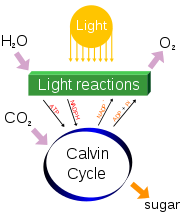Lab: Photosynthesis
| Photosynthesis is a process that converts carbon dioxide into organic compounds, especially sugars, using the energy from sunlight. Photosynthesis occurs in plants, algae, and many species of bacteria. Photosynthetic organisms are called photoautotrophs, since they can create their own food. In plants, algae, and cyanobacteria, photosynthesis uses carbon dioxide and water, releasing oxygen as a waste product.
Although photosynthesis can happen in different ways in different species, some features are always the same. For example, the process always begins when energy from light is absorbed by proteins called photosynthetic reaction centers that contain chlorophylls. In plants, these proteins are held inside organelles called chloroplasts, while in bacteria they are embedded in the plasma membrane. Some of the light energy gathered by chlorophylls is stored in the form of adenosine triphosphate (ATP). The rest of the energy is used to remove electrons from a substance such as water. These electrons are then used in the reactions that turn carbon dioxide into organic compounds. In plants, algae and cyanobacteria, this is done by a sequence of reactions called the Calvin cycle. This extract is licensed under the Creative Commons Attribution-ShareAlike license. It uses material from the article "Photosynthesis", retrieved 12 Apr 2011. |
This lab uses the floating disk leaf assay as a vehicle for exploring the action of photosynthesis in plants. Generally speaking, a leaf floats (due to the many intercellular spaces used for exchange of gases). When these intercellular spaces are instead filled with solution, the density of the leaf increases and it sinks. By providing the requirements for photosynthesis (light, CO2, and H20), oxygen will be produced in the leaf, even though the leaf is "underwater". As it is produced the oxygen gas will form small bubbles which will cause the leaf to again float.
But wait a minute. Isn't the leaf also engaged in respiration, which would use the oxygen produced by photosynthesis? The answer is yes, some of the oxygen will be used in the leaf's respiration process. If/when the leaf floats, it is because the net result is more oxygen produced by photosynthesis than used in respiration. In this lab, the rate at which small leaf "disks" rise to a floating position will be used as an indirect measure of the net production of oxygen produced by photosynthesis.[1][2]
Contents
Prep
In preparation for the experiment, read about photosynthesis (and optionally cell respiration) in a textbook or at one of the following sites:
Printout the materials and procedures for reference during the lab.
Basic floating leaf disc assay protocol
Use the following procedures to become familiar with the basic protocol.[1]
Materials
- Sodium bicarbonate (Baking soda)
- Liquid Soap
- Plastic syringe with needle removed (10 cc or larger)
- Leaf material (spinach and ivy work well)
- Hole punch
- Plastic cups
- Timer
- Light source
Procedure
Prepare a data table to record the results of the process.
Use the protocol specified in The Floating Leaf Disk Assay for Investigating Photosynthesis.
For a video demonstration of the infiltration technique, see [Leaf Disks].
Data analysis
The raw data from the procedure is the number of disks floating at each minute mark, until all of the disks are floating. Use the following to help make sense of the data[1]
- Graph the results using time as the independent variable.
- Using the graph, estimate the time at which 50% of the disks are floating, ET50.
How do we interpret ET50? Let's consider how ET50 varies as the rate of photosynthesis varies.
- In a low light situation, photosynthesis would proceed at a relatively slow rate. We would expect the rate of oxygen produced to be low, and the time at which 50% of the disks are floating to be relatively long.
- In a strong light situation, photosynthesis would proceed more rapidly. We would expect the rate of oxygen produced to be high and the time at which 50% of the disks are floating to be comparatively short.
We can conclude that the ET50 statistic is indirectly proportional to the rate of photosynthesis, the higher the rate of photosynthesis, the smaller the ET50 statistic.
This is a rather undesirable result. It would be easier to understand the meaning of the statistic if it were directly proportional, as the rate of photosynthesis increased the statistic is larger. To adjust for this, use the inverse, [math]\frac {1} {ET_{50}}[/math], for comparing the rate across conditions.
Design an experiment
Using the floating leaf disk assay protocol as a tool to measure the rate of photosynthesis, design an experiment to investigate how varying an environmental or plant condition effects the rate of photosynthesis.
Possible experimental questions
There are a number of questions which may be investigated using the floating leaf disk assay protocol.[2] Some areas for consideration:
- rate of respiration
- CO2 concentration
- light intensity
- light wavelength
- temperature
- pH
- amount of chlorophyll
- shade- vs. sun-adapted leaves
- herbicides
Design an experiment to investigate the effect of one of these environmental/plant conditions.
The article Investigation of Photosynthesis using the Floating Leaf Disk Assay has some thoughts on a number of these questions in the section, II. Predictions and experimental designs.
Materials
- Colored cellophane or filters
- Variegated leaf material (possibly variegated geranium)
- Leaf material from shade adapted plants
- Herbicide
Procedure
Carry out the experiment as designed.
Data analysis
Calculate [math]\frac {1} {ET_{50}}[/math] for each of the conditions and graph the results.
Additional resources
Notes
- ↑ 1.0 1.1 1.2 Williamson, B. The Floating Leaf Disk Assay for Investigating Photosynthesis, Exploring Life, accessed 13 Apr 2011.
- ↑ 2.0 2.1 Armstrong, J.E. Investigation of Photosynthesis using the Floating Leaf Disk Assay, BIOLAB, accessed 13 Apr 2011.
